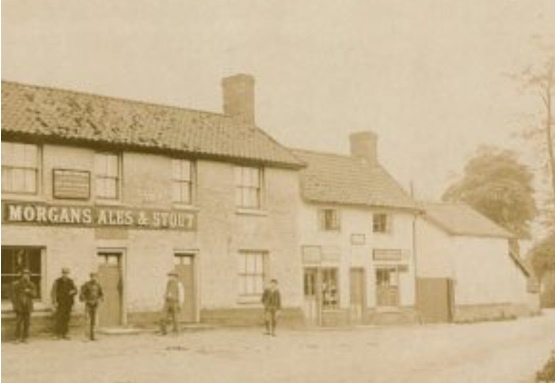
The above postcard shows the Crown Public House with the adjoining cottage (then two shops) to the right
Postcard courtesy Carol Ewin
Parts I, II, III, IV and V of the history of the ‘The Cottage adjoining the Crown Public House’ looks at the history of this delightful cottage through nearly three centuries.
We begin this blog with William Key’s purchase in 1925, and take the history forward some 40 years with Ronald Drewry’s purchase in 1964.
We end the series of blogs with some thoughts around the historical connection of the house to the adjoining Crown Public House.
Purchase Price £145
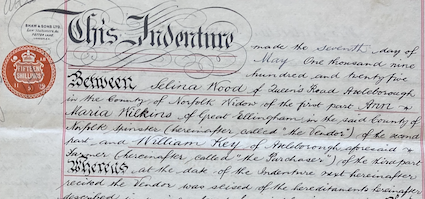
Extract from Conveyance 7th May 1925 Selina Wood, Ann Maria Wilkins & William Key
Courtesy Sue Simpson
On the 7th May, 1925, Attleborough farmer, William Key, completed his purchase of the cottage with shop, outbuildings and garden which adjoined the Crown Public House in Great Ellingham.
The premises were sold by Miss Anna Maria Wilkins at an agreed price of £145.
William Key
I believe that at the time of his purchase, William Key lived with his wife at Wood Farm, Attleborough.
1911 census
The 1911 census captures Mattishall born William Key (then aged 53) with his 59 year old wife Elizabeth and sons, Walter 21 and Bertie 17. The census confirms that the couple had completed 30 years of marriage during which time they had 11 children. Sadly four of the eleven children had died.
1925 Conveyance Deed
The 1925 Conveyance Deed to William Key tells us that the property had been occupied by Robert Dixon. However, Dixon had moved out some years earlier. Accordingly, the property may have been unoccupied for a while before William Key purchased it.
Occupiers Fred & Jessie Key
A son of William and Elizabeth Key, Frederick was born on the 13th February, 1891. Like his father, ‘Fred’ was born in Mattishall. However by 1901, Fred and his parents and siblings were at Wood Farm, Attleborough.
Army Service Corps
In 1915, at the age of 24, Fred Key enlisted with the Army Service Corps. He joined at Woolwich on the 4th March, 1915. Given that his service record gives his occupation as a harness maker, it is no surprise that Fred Key was given the role of a ‘saddler’.
Marriage
Fred married London born Jessie Eliza Hill in 1919. Their marriage was registered in the Wandsworth District between October and December 1919.
1921 census
The 1921 census captures the couple living in Attleborough. Fred’s parents were also living in Attleborough – I assume at Wood Farm.
Fred & Jessie move to The Cottage adjoining The Crown
It may be that Fred and Jessie Key moved into the cottage adjoining The Crown soon after William Key’s purchase was completed in 1925. The couple were certainly living there in 1928. By this time, Fred and Jessie had three children – Dorothy, Albert and Freda. Geoffrey followed in 1931.
William Key Dies
Widower William Key died on the 16th March, 1932. His wife Elizabeth had died in 1929.
By this time, Wood Farm was farmed by his son, Walter. William Key lived at Hill Common Farm, Attleborough.
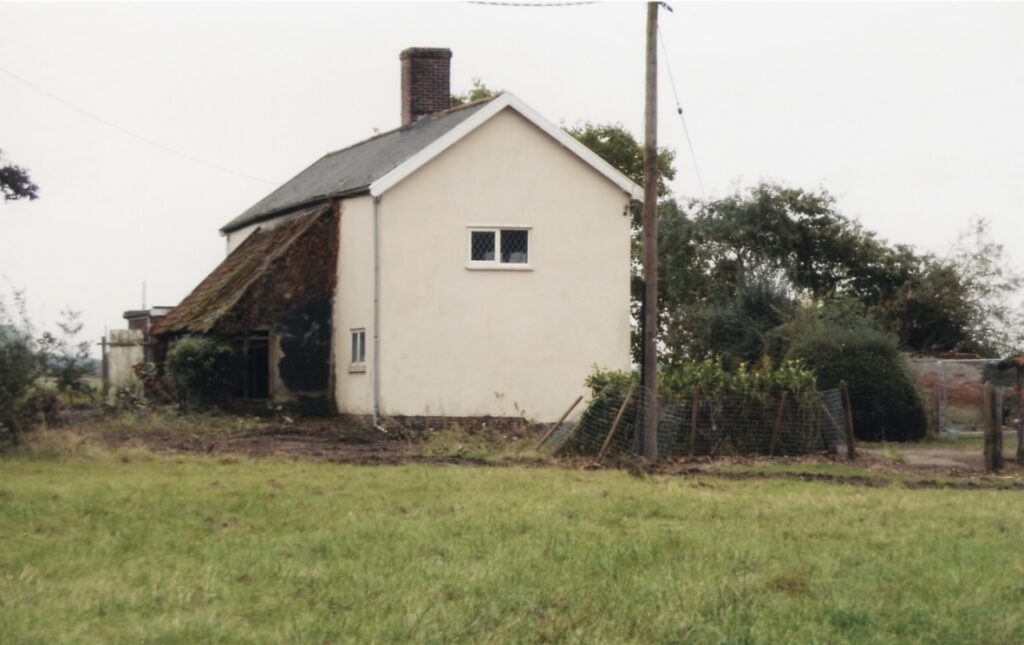
Hill Common Farm, Attleborough. The former home of William Key
Courtesy Robert Daniels
Following his death, William Key’s property would be sold with the proceeds divided equally between his children.
However, William provided in his will that his son Frederick is given the option of purchasing his (Fred’s) home in Great Ellingham i.e. the cottage adjoining The Crown. He also set a time scale in which Frederick could make such a request to his father’s executors.
Frederick Buys the Cottage
On the 7th April, 1932, Frederick gives the required notice to his father’s executors of his intention to purchase the property. A price of £140 was agreed.
The transaction was completed on the 29th September, 1932.
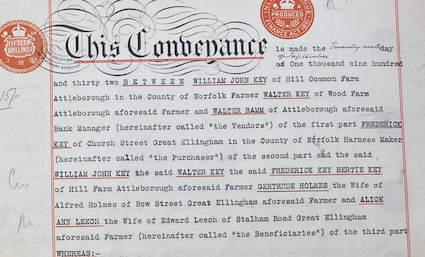
Conveyance dated 29th September 1932. Wm John Key & Others to Frederick Key
Courtesy Sue Simpson
The Conveyance Deed to Frederick shows that William Key left 6 surviving children, including his daughter Alice Ann Leech, the wife of Edward Leech.
Much later, Frederick’s widow Jessie Eliza Key married Edward Leech, the widower of Alice Ann Leech!
Harness Maker
Following Fred’s purchase, he and Jessie continued to live at the property in Church Street. Fred also continued his occupation as a harness maker.
Indeed Kelly’s Directory of 1937 lists Fred Key as a harness maker in Great Ellingham.
1939 Register
The 1939 Register for England & Wales captures Frederick and Jessie in the Street, Great Ellingham with Geoffrey, and (I believe) two other of their children. Also with the family is Jessie’s 75 year old mother, Clara Hill.
Evacuees
I know that just days before the outbreak of WWII, several Great Ellingham families welcomed evacuees into their homes. They included a number of children and staff from the London Fields School in Hackney. The Key family was no exception.
The 1939 Register also shows 52 year old Daisy I Kirkby and 43 year old Eva E Francis with the household of Frederick and Jessie Key. Daisy a teacher with the then London County Council and Eva is described as ‘help with evacuees’.
Living next door – and perhaps occupying part of Frederick Key’s property, is 35 year old London County Council School Master William G L Tonkin with his wife Hilda and their 11 year old son William.
1942 Invasion Committee Record
Three years’ later, the Great Ellingham Invasion Committee Record of 1942 lists Fred Key’s household as follows: Mr F Key (Home Guard), Mrs Jessie Key (General Utility Duties), Mr Albert [Key] (Home Guard), Miss D Key (Casualty Service), Geoffrey [Key] cadet and R Goldclang, (whom I believe to be an evacuee).
Living nearby with ‘Mrs Fincham’ is another evacuee – D Goldklang. I think it more than possible that the Goldklangs were evacuated children and were related.
Death of Clara Hill
Two years earlier, Jessie Key had buried her 75 year old mother, Clara Hill, in the churchyard of St James.
Death of Fred Key
Frederick Key of Church Street, Great Ellingham died on the 7th March, 1943, at West Beckham, Norfolk. Given that Fred Key did not leave a will, his death may have been unexpected. Nevertheless, administration of her late husband’s affairs was granted to his widow, Jessie Eliza Key, in April 1943.
Jessie became the owner of her late husband’s property adjoining the Crown.
Jessie Key Buys a Detached Cottage in Long Street
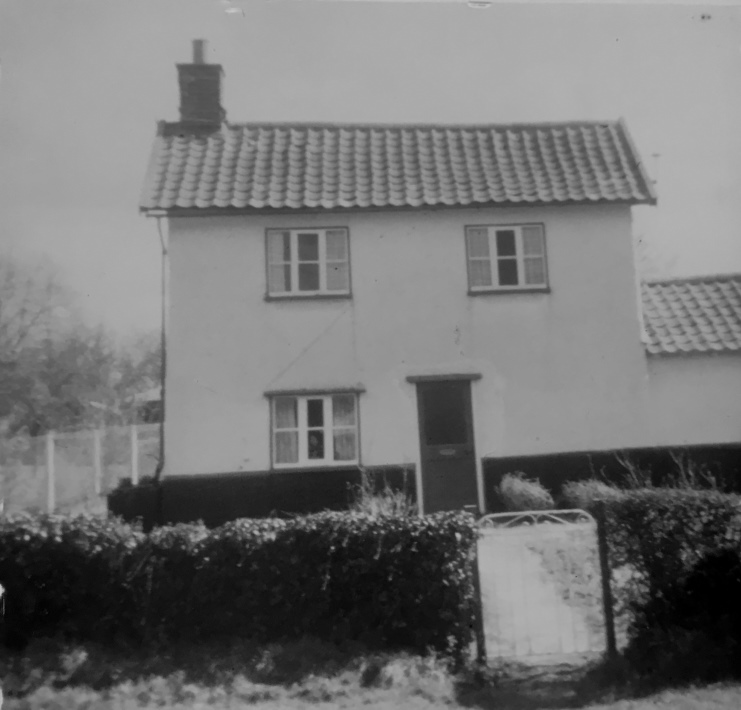
Jessie Key’s Detached Cottage in Long Street
Courtesy Ian Butler
In April, 1948, widow Jessie Eliza Key purchased a detached cottage in Long Street, Great Ellingham – not far from the Post Office.
Jessie Key sells the Premises adjoining The Crown
On the 3rd November, 1948, Jessie Key completed the sale of her cottage and shop which adjoined the Crown Public House.
She had already moved into her detached cottage in Long Street.
The sale proceeded by way of a series of sub-sales. Jessie had agreed the sale to Hubert John Bush of Little Ellingham. However before the transaction completed, Bush agreed a subsequent sale to Brandon shopkeeper Arthur Edwin Brookfield. Nevertheless, it was Albert Leonard Holman of Caston who ultimately purchased the property.
Once again the 1948 Conveyance Deed to Holman uses a description of the property which very nearly mirrors the wording used in a Conveyance Deed some 80 years earlier in 1868:
ALL THAT cottage or tenement with the shop outbuildings yard and garden land and appurtenances thereto belonging situate lying and being in Great Ellingham in the County of Norfolk and bounded on the North by the Public Road leading from Watton to Deopham and Rocklands and now known as Church Street on the South by land formerly belonging to the Executors of Jonathan Rivett on the East by the Inn known as “The Crown” and on the West by the Wesleyan Methodist Chapel ..
Albert L Holman
At the time of his purchase, Albert Holman lived at Church Farm, Caston. The Conveyance Deed gives Albert Holman’s occupation as a farmer.
However, I believe he moved into the Church Street property.
Good Description of the Property
A Fire Insurance policy of November 1948 provides a good description of the property as it was at that time.
On the whole, the house was built of brick and clay with a tiled roof. The policy refers to a detached outbuilding used in connection with Albert Holman’s trade as a mushroom cultivator, as well as ‘a range’ of timber built outbuildings also used for Albert’s business.
Nonetheless, it seems that Albert Holman’s ownership of the property was short-lived. It also appears that by the time Albert sold the property a year later, he had become a builder.
Additional Land and an Additional Well!
During the previous year, Albert had also purchased a piece of land to the rear of the property. He had also sunk a well within the curtilage of the whole property. In effect, the property now had access to and the use of two wells – the new well which had recently been sunk in addition to the well on the adjoining premises to the east of the property i.e. The Crown.
Four Owners in Two Years
Holman sells to France
Just a year after he had purchased the property, Albert Holman sold the premises to spinster Doris France of Bacton. The transaction completed on the 30th November, 1949.
Doris France lived in the property. However, six months’ later, Doris sells the property.
France sells to Rhead
By a Conveyance Deed of the 2nd May, 1950, Doris France of Church Street, Great Ellingham sold the property to Dudley and Eleanor Rhead. The couple had moved from Rickinghall Superior in Suffolk.
Rhead to Greenwood
Just over five months’ later, Dudley and Eleanor Rhead put the property (then known as ‘Northernhay’) up for sale at auction.
Particulars for the auction held at the Royal Hotel, Attleborough on the 26th October, 1950, provides us with another good description of the property.

Extract from Auction Particulars prepared for the sellers, Dudley & Eleanor Rhead.
Auction held at the Royal Hotel, Attleborough on 26th October, 1950
Courtesy Sue Simpson
The Particulars also state:
“Northernhay” is a well situate Property and in a very good state of repair. The main portion of the House is of modern construction with rooms of good height and large windows. Two bedrooms and one sitting room are older with old oak beams and studs, but this part has been carefully bricked up to correspond with the newer portion. The House has been modernised with the exception of a bathroom, which can be installed at small expense and can be connected to the existing water supply and drainage.
William & Nellie Greenwood
Licensed victualler, 63 year old William Greenwood and his wife Nellie, successfully bid for the property at the auction. Halifax born William Greenwood had been landlord of ‘The Prince of Wales’ Pubic House in Norwich Road, Besthorpe since at least 1939.
As far as I know following the purchase, William and Nellie continued to live at the Prince of Wales in Besthorpe.
They may have initially let their Great Ellingham property. However, by 1954 their son, Basil, lived at the property. Indeed following Nellie’s death in 1954, William Greenwood (then retired and living in Attleborough), conveyed the property to Basil.
1954 New Owner Basil Greenwood
On the 22nd February, 1954, Basil Greenwood completed the purchase of “Northernhay’ from his father, William Henry Greenwood.
A mechanic, Basil Greenwood had been living at the property with his wife Lilian.
Basil and Lilian Greenwood continued to live at the property until he sold the property to Herbert Norton on the 25th March, 1960. I believe Basil and Lilian then moved to Chequers Lane.
1960s
Within weeks of his purchase of “Northernhay”, Herbert Norton sold the property on the 12th April, 1960, to Ronald George Jones. Given that the Conveyance Deed gives “Northernhay” as the address for Ronald Jones, it seems likely that Ronald Jones already occupied the property.
On the 10th January, 1964, Ronald Jones (who had already moved to Enfield in Middlesex), sold ‘Northernhay” to bus conductor Ronald Jack Drewry and his wife Helen. Ronald and Helen had been living in Haslingfield, Cambridgeshire.
It may well have been around this time that Ronald Drewry took over as the landlord of the adjoining Crown Public House.
A Local Man
Although at the time of his purchase, his home was in Cambridgeshire, Ronald Drewry was a local man.
He was one of seven known children of Hockham born Frederick Drewry and his wife Edna May (nèe Warren). The couple married in 1922.
1939 Bow Street
The 1939 England & Wales Register captures farm labourer Frederick Drewry with his wife and family in Bow Street.
The Drewry’s two-bedroomed Bow Street cottage had no kitchen and no inside toilet. It must have been quite a squeeze too when everyone ‘was home’ at the same time.
There was also no running water. Like their neighbours, the Drewrys obtained their water from a well in the garden.
Home in Church Street
Ronald Drewry’s home in Church Street, Great Ellingham was indeed much larger than his childhood home in Bow Street. I also wonder whether Ronald’s home in the 1960s had, by then, been fitted with the ‘modern conveniences’ such as a bathroom and mains water.
Changes over the Centuries
Over the last 270 years or so, the house adjoining the Crown Public House has certainly seen the ‘comings and goings’ of several families throughout this time.
The house itself has also undergone many changes too – both inside and out.
Cottage
In 1749, the property was described as a ‘Cottage’ – is there any part of this cottage within the house which we can see today? I think there probably is.
Shops
There may also be some evidence of the shop premises which also once formed part of this house. For example, William Rose’s grocer’s shop, harness makers Henry Warren and Fred Key. Cycle Dealer, Bertie Wilkins who also had a butcher’s shop and post office at the premises.
Extension
Before 1913, a large extension was added to the house.
When Bertie Wilkins offered the property for sale in 1913, the premises comprised a butcher’s shop, cycle shop as well as a dwelling-house. There were two good living rooms, scullery, pantry and four bedrooms. At the rear of the property, there was a slaughterhouse pound, a carpenter’s shop as well as two sheds and a large yard.
Services
By 1950, the house had mains electricity.
Water was now pumped from a well (sunk during Albert Holman’s tenure), to the sink and to the W.C. with drainage to a septic tank. However at that time, there was still no bathroom.
All very much different from the ‘facilities’ of a much earlier age with cooking on open fires and oven ranges; with ighting from tallow candles and oil lamps – a possible cause of the historical fires to nearby buildings, and a toilet most likely comprising an outside shed with a plank and bucket!
Final Note
My investigations of the historical deeds are limited. Save for references to earlier deeds including an Indenture of 1749, they do not extend earlier than 1819.
Stables
However, it is believed that the front part of the house may well have once been the stables for the Crown Public House. Indeed, it has been reported that when some pamments were lifted, there was a distinct smell of horses!
However, we know that around 1911 Bertie Wilkins had his butchery business at the property. To the rear was a slaughterhouse pound.
Earlier and later than 1911, the property was occupied by harness makers.
Could any of these occupations account for the ‘smell of horses’?
Cellar
Further, there is evidence in the house of a filled in cellar. This cellar is also thought to have been once part of the Crown.
Given that I have not found any specific reference to the stables or the cellar in the limited deeds I have seen, I would tend to think that if these areas were once part of the Crown, then it would have been earlier than 1749.
Fire
We should also bear in mind that according to newspaper reports, the Crown was totally destroyed by a fire in 1787. The fire had spread from ‘Widow Caddy’s home’ which adjoined the Crown.
My investigations lead me to believe that this house was not ‘Widow Caddy’s Home’. However, and particularly that fire control then would have been limited, this house may well have been affected by the fire.
However, the limited deeds make no reference to the re-building of the Crown or this house following the fire in 1787.
It is also possible that the stables and cellar were part of an earlier property on the site. More investigations are needed!
Sources:
Private Deeds Collection. Thanks to Sue Simpson
1901 census RG13/1867/34
1911 census RG14/11470/98
1921 census. Online search only used. www.findmypast.co.uk
1939 England & Wales Register. The National Archives; Kew, London, England; 1939 Register; Reference: Rg 101/6590h. Ancestry.com. 1939 England and Wales Register [database on-line]. Lehi, UT, USA: Ancestry.com Operations, Inc., 2018.
1942 Great Ellingham Invasion Committee Record. Sue Fay
Fred Key. UK British Army World War I Service Records, 1914-1920. The National Archives; Kew, Surrey, England; War Office: Soldiers’ Documents, First World War Wo363. Ancestry.com. UK, British Army World War I Service Records, 1914-1920 [database on-line]. Lehi, UT, USA: Original data: The National Archives of the UK (TNA): Public Record Office (PRO).
Marriage Key Frederick HILL Dec Qtr 1919 Wandsworth 1d 1668a FreeBMD website
1937 Kellys Directory
Private Deeds Collection. Thanks to the Butler Family
Thanks to David Fowle for the description of his Drewry grandparents’ home in Bow Street